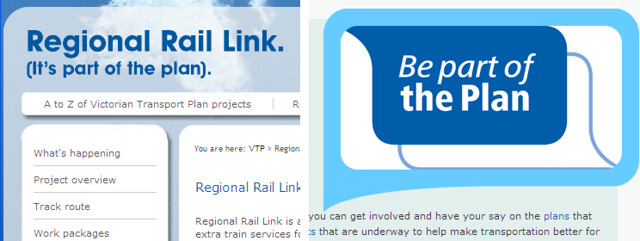Left: Victoria. It’s part of the plan.
This is the plan. If you don’t like it, tough, you’ll get what you’re given.
Right: Vancouver, Canada. Be part of the plan.
What do you think? Have your say. Tell us what you want.
Something which I’m hoping the Coalition’s Public Transport Development Authority will resolve is the culture of secrecy that surrounds decision-making in transport. While they do take submissions on some topics, the process that considers them isn’t transparent. The Department of Transport will come out with plans that sometimes make sense, sometimes don’t, but often it will be very difficult to find out why they’ve come to a particular conclusion. It took a lot of digging, for instance, to find out why on earth the South Morang rail extension would cost $562 million for just 3.5 kilometres.
Perhaps the worst case was the now infamous case of the Regional Rail Link plans, which were announced in public to the media and invited guests before the people whose houses would be demolished for it were informed.
In contrast Vancouver’s Translink (which actually manages all forms of transport in Vancouver, not just public transport) actively engages with the public, and even has a public Annual General Meeting where people can come along and ask board members questions — and judging from that post, get meaningful answers.
Now that really would be refreshing.

8 replies on “Spot the difference”
I’ll let Andrew S spell out not just the cost discrepancy on the South Morang extension, but on many of the other transport projects. When you realize what magnitude the blowouts are, you’ll thank God that we turfed Brumby out!
I think my comment in the previous post regarding the Sunbury electrification highlights the problem:
http://www.danielbowen.com/2010/11/29/election-trains/#comments
but the South Morang extension is worse (even with the track duplication, Clifton Hill-Westgarth bridge, etc), especially when its extent will be out of date when its open!
I’d hate to think what they’d budget for the Doncaster or Rowville lines or the Trans Australia Railway if they were doing it now!!!!!!
Trans-Link is NOT the touchy-feelie public body that you might be assuming. But, they do have a way with words …
The unified transit body concept extends to all the roads in the region. The provincial government has more or less washed their hands of the entire morass of public and private transit in the Lower Mainland, with the result that Trans-Link finds itself in charge of bridge building, buses, elevated and subway systems, divided highways and a heavily subsidized rail commuter train system.
A board appointed by the municipalities and regional districts is responsible for operating Trans-Link. They are also responsible for finding the funds to operate this disparate group of responsibilities.
It works just about as well as you might imagine. But not quite.
Because we have a new transport minister. Does the transport plan still go on? Does Tarniet and Whyndam Vale stations still get built?
Phil – Regional Rail Link (Tarneit and Wyndham Vale stations) has already essentially been funded by the Feds so I would assume it will still go aherad. Not so sure about the tunnel though.
Given the development out that way, the new Tarneit and Wyndham Vale stations appear to be catering for suburban traffic along the new line designed for V/Line train use only – are these to operate as the Melton, Sunbury and Stony Point Lines do currently? It seems to be another vague issue with the project like the land acquisition one.
“heavily subsidized rail commuter train system”
Vancouver doesn’t have a heavily subsidised rail network nearly 50% of it’s revenue comes from the farebox and then there is a small portion that comes from advertising and “other” (I don’t have the time to find out what “other” covers yet).
It’s certainly not the best rate of return globally, but it’s a lot better than most cities around the world.
@ace, thanks for the comments.
@Julian, might be referring to West Coast Express. Part of its problem is it is literally a Commuter-only service, and from the looks of it, each train in its fleet runs just two trips per weekday, which probably means it does have a high subsidy, since the return on investment must be quite low.
http://en.wikipedia.org/wiki/West_Coast_Express
Daniel, exactly right. I was referring to the West Coast Express from Mission to downtown Vancouver. I believe that a large fee is paid to CP Rail to use their lines, and the trains only run the weekday commutes.